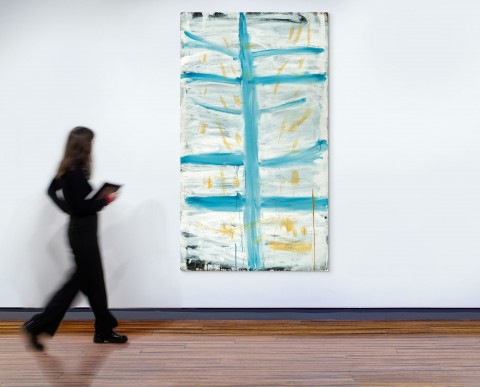BLUE VERTICAL ON WHITE AND YELLOW, 1971
TONY TUCKSON
synthetic polymer paint on composition board
213.5 x 122.0 cm
Private collection, Sydney, a gift from the artist in 1972
With Tony Tuckson’s first solo exhibition held in 1970, he was immediately placed in an inimitable position in modern Australian painting. Critical reaction to this exhibition and another in 1973 singled him out as an abstract painter of rare distinction – large expressive works of sublime grandeur. It was also the year of his premature death, age 52.
Tuckson’s formative interest in Modernism was figurative, with European modernism – especially the School of Paris – shaping his approach. He had studied art in his native England (he was born in Egypt), flew Spitfires in WWII and was sent to Darwin in 1942. After the war he attended East Sydney Technical College where Grace Crowley and Ralph Balson taught, and each played an important role in further developing Tuckson’s outlook on modern painting.
In 1950 Tuckson was appointed to the staff of the Art Gallery of New South Wales, becoming its deputy director in 1957. He developed a keen and deep appreciation of Aboriginal and Melanesian art, and this not only shaped the Gallery’s collection, but also informed his own art. An echo of Ian Fairweather’s approach to painting is one discreet and recurring presence in Tuckson’s work. It is not stylistic, but rather an attitude to painting itself – a philosophy about making art. And they each shared an enduring interest in Aboriginal art and the culture which created it.
Marks, gestures, lineal designs across cultures – and the meanings they hold – became critical to Tuckson’s intellectual temperament. American Abstract expressionism in particular can be regarded as a decisive underpinning in the final paintings and drawings, with Tuckson encountering the movement during a study trip in 1967 – 68. Great post-war abstractionists abounded in New York. In the work of artists such as de Kooning, Newman, Rothko, Pollock, Motherwell and Twombly, Tuckson saw the conceptual and emotional possibilities inherent in abstraction.
In Blue Vertical on White and Yellow, 1971 we might be tempted to look for something observed in the central blue arrangement, but that would be a distraction. Literalism was Tuckson’s anathema.
The blue fluid-brushed, translucent calligraphic sweeps and the accents of yellow reach across white scumbling underpainting. Painterly incidents, dribbles and the shifts in underpainting serve as a veil for the overpainting. The blue becomes an ensemble of simple gestures and avoids any distractions of ‘finish.’ Hardboard especially was a common support for Tuckson, a surface plane with no resistance, something able to accommodate the physical immediacy in creating each work. All Tuckson’s final paintings began with forethought, but the process itself shaped their ultimate character. None suggests any sort of metaphor or understated symbolism, and titles to suggest anything beyond a pictorial description are rare.
When a family friend visited Tuckson, his studio window was open, a breeze parting the curtains offering glimpses to bushland that surround his Wahroonga home. She asked about the meaning of a painting: ‘It’s about this’, Tuckson said, fixated on the motion of the curtains, and then, with a surging gesture, he emphasised, ‘and everything out there.’1
1.Mimmocchi, D., et al., Tony Tuckson, Art Gallery New South Wales, Sydney, 2018, p.18
DOUG HALL AM

